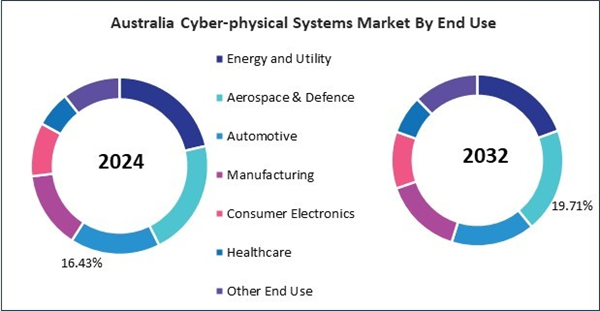The China market dominated the Asia Pacific Cyber-physical Systems Market by country in 2024, and is expected to continue to be a dominant market till 2032; thereby, achieving a market value of $38.80 billion by 2032. The Japan market is showcasing a CAGR of 14.5% during 2025-2032. Additionally, the India market would register a CAGR of 16.2% during 2025-2032.
The applications of Cyber-Physical Systems are extensive and diverse, driven by the increasing demand for automation, intelligence, and interconnected systems. In the manufacturing sector, CPS plays a vital role in enabling smart factories where machines, storage systems, and production facilities communicate autonomously and in real time. These smart factories utilize CPS for predictive maintenance, adaptive manufacturing, quality control, and supply chain optimization. In healthcare, CPS has brought about revolutionary changes through wearable devices, remote patient monitoring systems, and robotic surgical systems that enable precision and personalized medicine. Smart energy systems represent another critical application of CPS, where smart grids use intelligent sensors and analytics to manage energy production, distribution, and consumption efficiently.
In transportation, CPS facilitates the development of autonomous vehicles, intelligent traffic systems, and connected infrastructure that significantly enhance road safety and traffic efficiency. Similarly, in agriculture, CPS technologies are enabling precision farming, with the help of sensors, GPS, and data analytics tools that optimize irrigation, fertilization, and crop monitoring. The aerospace and defense sectors also extensively rely on CPS for real-time monitoring, unmanned vehicles, automated mission control, and cyber-resilient infrastructure. From home automation to industrial robotics, and from environmental monitoring to urban planning, the versatility of CPS applications is vast and expanding rapidly.
Market trends highlight the integration of CPS in smart city projects, manufacturing, and agriculture. The government's Smart Cities Mission, initiated in 2015, leverages CPS to enhance urban infrastructure and services. The competitive landscape includes a mix of startups and established firms like Tata Consultancy Services and Infosys, focusing on CPS solutions. Collaborations between academia and industry are fostering innovation, while government policies support the growth of a secure and robust CPS ecosystem.
Australia's Cyber-Physical Systems market is evolving, with a focus on integrating CPS into sectors like defense, energy, and manufacturing. Companies such as Consunet have made significant strides, secured major defense contracts and expanding their operations. Key influencing factors include government initiatives like the National Reconstruction Fund, which allocates funds for critical technologies and advanced manufacturing. Additionally, the Security of Critical Infrastructure Act mandates enhanced cybersecurity measures for industries, including those implementing CPS.
In the broader Asia-Pacific region, countries like Indonesia and Vietnam are making strides in adopting Cyber-Physical Systems. Indonesia's "Making Indonesia 4.0" initiative focuses on improving industrial performance through CPS integration. Key influencing factors across the region include government policies aimed at digital transformation, investments in infrastructure, and a growing emphasis on innovation. The adoption of CPS is seen as a means to enhance productivity, competitiveness, and economic growth. Market trends involve the implementation of CPS in sectors like manufacturing, agriculture, and transportation.
List of Key Companies Profiled
- Siemens AG
- Honeywell International Inc.
- Rockwell Automation, Inc.
- ABB Ltd.
- Schneider Electric SE
- Continental AG
- General Electric Company
- Hitachi, Ltd.
- Robert Bosch GmbH
- Emerson Electric Co.
Market Report Segmentation
By Type
- Closed-Loop
- Open-Loop
By Security
- Internet of Things (IoT) Security
- Embedded Security
- Industrial Control Systems (ICS) Security
- Robotic Security
- Other Security
By Component
- Hardware
- Software
- Services
By End Use
- Energy and Utility
- Aerospace & Defence
- Automotive
- Manufacturing
- Consumer Electronics
- Healthcare
- Other End Use
By Country
- China
- Japan
- India
- South Korea
- Australia
- Malaysia
- Rest of Asia Pacific
Table of Contents
Companies Mentioned
- Siemens AG
- Honeywell International Inc.
- Rockwell Automation, Inc.
- ABB Ltd.
- Schneider Electric SE
- Continental AG
- General Electric Company
- Hitachi, Ltd.
- Robert Bosch GmbH
- Emerson Electric Co.









